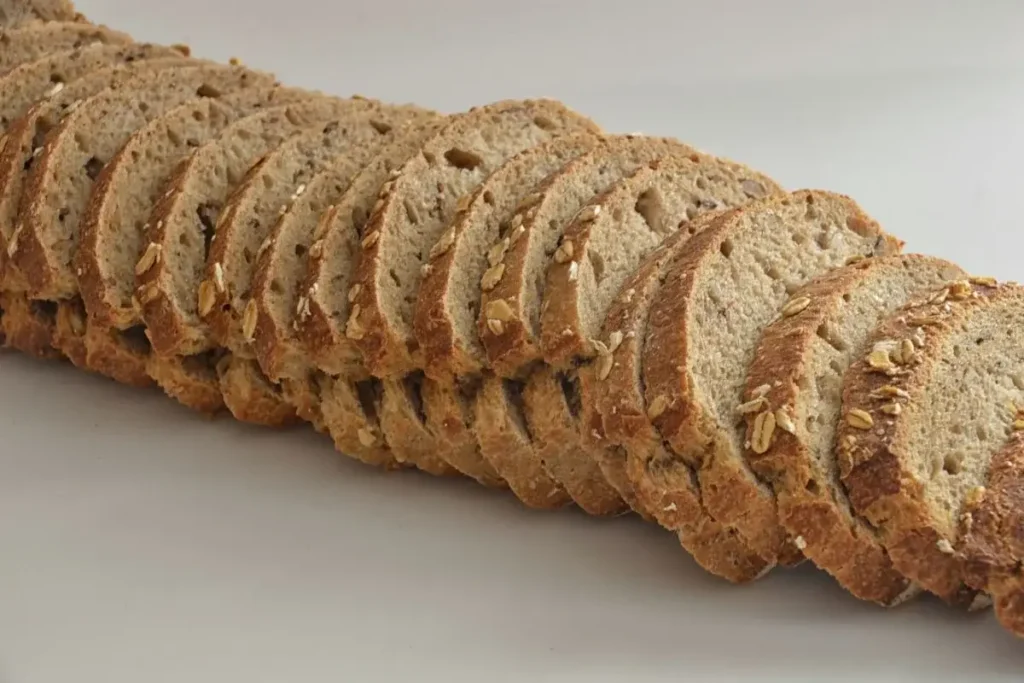
Ever wondered if you can toss your whole wheat bread in the freezer without messing up the taste and health perks? Well, the answer is a big yes! Freezing not only keeps your bread fresh for longer but also helps cut down on food waste and allows you to buy in bulk.
In this blog, we’ll break down the ins and outs of freezing whole wheat bread, giving you a step-by-step guide and some useful tips. From clever packaging ideas to defrosting hacks, we’ll spill the beans on how to keep your frozen slices just as tasty.
And hey, we’ll even dive into the great debate: freeze the whole loaf or slice it up first? Get ready to uncover the secrets of storing whole wheat bread like a pro, making your kitchen life easier and ensuring a steady supply of wholesome goodness.
Table of Contents
ToggleCan Whole Wheat Bread Be Frozen?
Many people consider whole wheat bread a dietary essential, and a common question is whether it can be frozen without losing its taste and nutritional benefits. The simple answer is yes—whole wheat bread can definitely be frozen, and it comes with a bunch of advantages.
Freezing whole wheat bread is a handy solution for those looking to make it last longer and cut down on food waste. The process involves smart packaging to keep the bread’s texture and taste intact for an extended period. Just slice the bread into manageable portions and wrap each slice tightly in plastic wrap to create a protective barrier against the freezer.
The perks of freezing whole wheat bread go beyond just being convenient. This method allows you to buy in bulk, take advantage of sales, or ensure a steady supply of fresh bread without worrying about it going stale. It’s an efficient way to maintain a healthy diet by including whole grains, even when you’re short on time or your eating habits vary.
In the following sections, we’ll explore the right way to freeze whole wheat bread, providing a step-by-step guide and useful tips to get the best results.

How to Properly Freeze Whole Wheat Bread in the Freezer
Freezing whole wheat bread is pretty simple, but doing it right ensures your bread stays yummy, and you can grab fresh slices whenever you want. Just follow these steps:
- Slice It Up: Cut your whole wheat bread into pieces that work for you. Slicing makes it easy to handle and helps you thaw only what you need, so you don’t waste any.
- Wrap Each Slice: After slicing, tightly wrap each piece in plastic. This keeps out air and moisture, which can mess with your bread’s texture and taste in the freezer.
- Double Up with Freezer Bags: Once each slice is wrapped, put them in a sturdy freezer bag. Make sure it’s meant for freezing – it adds an extra layer of protection. Squeeze out extra air before sealing to avoid freezer burn.
- Label and Date: Note the freezing date on the bag. This helps you keep track and ensures you eat the older slices first.
- Smart Freezer Placement: Where you put the bread in the freezer matters. Pick a spot with a steady temperature – avoid the freezer door as it can get too warm.
- Thawing Tricks: When it’s time to munch on your frozen whole wheat bread, thaw it gradually. Skip the microwave to keep the texture intact. Put the slices on the counter or in the fridge for a slow thaw.
- No Refreezing: Once it’s thawed, don’t refreeze. It can make the bread lose moisture and mess with the texture. Plan when to thaw to avoid unnecessary cycles.
- Quality Check: Before digging in, check for freezer burn – dry or discolored spots. If it looks and smells fresh, you’re good to go.
- Boost Freshness with Vacuum Sealing: For an extra freshness boost, think about getting a vacuum sealer. It removes extra air, keeping your whole wheat bread top-notch in the freezer.
- Store in Small Batches: If you can, freeze your bread in small batches. It makes things more organized and helps you manage your frozen stash better.
Is it Better to Freeze Whole Wheat Bread Whole or Sliced?
The whole debate about whether to freeze whole wheat bread as a whole loaf or sliced is pretty common. The answer depends on a few things like convenience, keeping it fresh, and personal preferences.
Freezing Whole Wheat Bread as a Whole Loaf
Freezing the whole loaf is a straightforward way to go. If you like to slice your bread fresh each time, freezing it whole might be your thing. Doing this keeps the air exposure low, which helps keep the moisture and texture of the bread. But, there are a few things to think about.
Pros:
- Keeps Moisture: Freezing the whole loaf keeps the moisture all through it.
- Preserves Texture: The crust stays crispy when you thaw it.
Cons:
- Takes Time to Thaw: Thawing a whole loaf takes longer than individual slices, not great if you need bread ASAP.
- Slicing Challenges: Slicing it after thawing might not give you even pieces.

Freezing Sliced Whole Wheat Bread:
Slicing the bread before freezing is a more practical and flexible approach. It thaws faster, is easier to manage in terms of portions, and suits those who want a quick and efficient solution.
Pros:
- Thaws Quickly: Sliced bread thaws faster, handy when you need bread in a hurry.
- Portion Control: You can easily grab the number of slices you want, reducing waste.
- Easy Storage: Sliced bread is usually more convenient to store in the freezer, especially if you have limited space.
Cons:
- Possible Moisture Loss: Sliced bread might lose some moisture, affecting its texture.
How Long Can Whole Wheat Bread Last in the Fridge?
Storing whole wheat bread in the fridge can be a handy way to make it last longer, but it affects how it feels and tastes. Usually, putting whole wheat bread in the fridge makes it dry out faster because it’s colder, speeding up the process of it getting stale. While keeping it cold helps stop mold and spoilage, it might make the bread less fresh.
Normally, whole wheat bread can stay good in the fridge for around 7 to 10 days. The exact time depends on things like how fresh the bread was to start with, the preservatives it has, and how it’s stored. It’s important to seal the bread up tight in a plastic bag or a container that doesn’t let in air and moisture, which can make it go stale.
If you won’t eat the bread within a week, think about freezing some of it. Freezing can make whole wheat bread last much longer, up to three months. When you want to eat it, let the bread thaw at room temperature or use a toaster to bring back its texture.

My Personal Tips for freezing Whole Wheat Bread
Freezing whole wheat bread has become a game-changer in my kitchen, allowing me to minimize waste and always have a stash of fresh bread on hand. Over the years, I’ve honed a few personal tips to ensure that the frozen whole wheat bread retains its quality and taste.
Firstly, before freezing, I slice the whole wheat bread into individual portions. This not only makes it more convenient for grabbing a quick piece but also facilitates the thawing process. I opt for slices of a thickness that suits my preferences, usually around half an inch, and separate them with parchment paper to prevent sticking.
To maintain the bread’s moisture during freezing, I double-wrap each portion. I use plastic wrap as the initial layer to create a tight seal around the bread, followed by a layer of aluminum foil. This dual-layered approach helps prevent freezer burn and preserves the bread’s freshness.
Labeling is a crucial step in my freezing routine. I make it a habit to include the date of freezing on each package, ensuring that I can keep track of the bread’s age and prioritize consuming older slices first. This simple practice helps me maintain a rotation system, minimizing the chances of finding forgotten loaves in the freezer.
When it comes to thawing, patience is key. I prefer letting the whole wheat bread thaw at room temperature to preserve its texture and flavor. If I’m in a hurry, using a toaster or oven at a low temperature provides a quick yet effective alternative.
Frequently Asked Questions (FAQS)
How long does bread last in the freezer after expiration date?
Bread can be safely stored in the freezer for 2-3 months after the expiration date. Ensure it’s well-sealed to prevent freezer burn. Thaw in the refrigerator for best quality, and use within a week for optimal taste and texture.
What is the best way to store whole wheat bread?
To maintain freshness, store whole wheat bread in a cool, dark place like a bread box or a pantry. Alternatively, refrigerate it in a sealed plastic bag to extend its shelf life. Avoid storing it in the fridge long-term, as it may dry out.
Does Freezing bread make it healthier?
Freezing bread doesn’t inherently make it healthier, but it preserves its freshness. Nutrient levels remain stable, and freezing can even slow down the staling process. However, a balanced diet with fresh whole grains is ideal for optimal nutrition. Thaw frozen bread and consume promptly for the best quality.
Can You Put Whole Wheat Bread in the Freezer | Final Thoughts
In short, freezing whole wheat bread is a smart way to keep it fresh, cut down on food waste, and make sure you always have a supply of healthy bread. Whether you freeze the whole loaf or slices, it’s important to use the right methods like good packaging, labeling, and placing it strategically in the freezer.
Thawing slowly and avoiding refreezing are key steps to keep the texture and taste just right. Personally, I’ve had success by slicing the bread before freezing, using a double-wrap method, and being patient during the thawing process.
These practices have made freezing whole wheat bread a regular thing in my kitchen, making things easier and reducing waste.
Lindsey Mackenzie
About me
Hi there! I’m Lindsey Mackenzie, the founder of Bake Smartly. Baking has been my passion since childhood, growing up in my father’s bakery. With Bake Smartly, I’m excited to share my love for all things sweet and savory. Join me on this delicious journey as we whip up scrumptious treats and sprinkle joy into every bite!






